Report on Workplace Discrimination: Single Parents and Disabled People
VerifiedAdded on 2022/11/10
|9
|2070
|447
Report
AI Summary
This report provides a comprehensive analysis of workplace discrimination, focusing on the challenges faced by single parents and individuals with disabilities. The report begins by defining single parents and disabled individuals, then delves into the specific forms of discrimination they encounter, including sexism, social stigma, prejudices, and preconceived notions. It explores the application of diversity management theories, such as the secondary and primary dimensions of diversity, to address these issues and proposes effective cross-cultural communication strategies to foster inclusivity. The report also outlines a diversity management action plan, offering practical steps for organizations to create more equitable and supportive work environments. It emphasizes the importance of understanding the psycho-social behavior of single parents and providing assistance to disabled individuals to ensure they feel comfortable and respected in the workplace. The report concludes by highlighting the benefits of fostering a diverse and inclusive environment for both organizations and society as a whole.
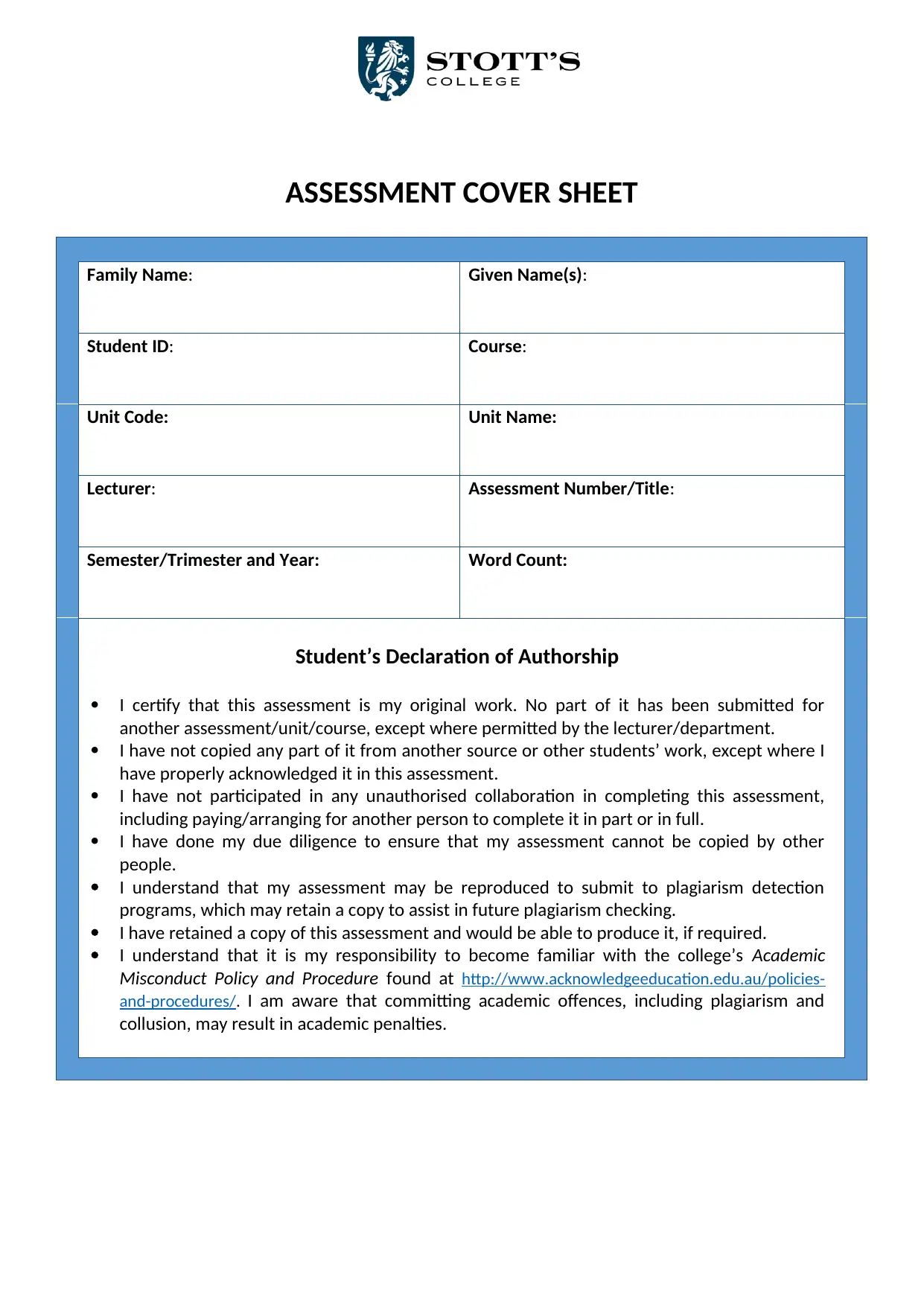
ASSESSMENT COVER SHEET
Family Name: Given Name(s):
Student ID: Course:
Unit Code: Unit Name:
Lecturer: Assessment Number/Title:
Semester/Trimester and Year: Word Count:
Student’s Declaration of Authorship
I certify that this assessment is my original work. No part of it has been submitted for
another assessment/unit/course, except where permitted by the lecturer/department.
I have not copied any part of it from another source or other students’ work, except where I
have properly acknowledged it in this assessment.
I have not participated in any unauthorised collaboration in completing this assessment,
including paying/arranging for another person to complete it in part or in full.
I have done my due diligence to ensure that my assessment cannot be copied by other
people.
I understand that my assessment may be reproduced to submit to plagiarism detection
programs, which may retain a copy to assist in future plagiarism checking.
I have retained a copy of this assessment and would be able to produce it, if required.
I understand that it is my responsibility to become familiar with the college’s Academic
Misconduct Policy and Procedure found at http://www.acknowledgeeducation.edu.au/policies-
and-procedures/. I am aware that committing academic offences, including plagiarism and
collusion, may result in academic penalties.
Family Name: Given Name(s):
Student ID: Course:
Unit Code: Unit Name:
Lecturer: Assessment Number/Title:
Semester/Trimester and Year: Word Count:
Student’s Declaration of Authorship
I certify that this assessment is my original work. No part of it has been submitted for
another assessment/unit/course, except where permitted by the lecturer/department.
I have not copied any part of it from another source or other students’ work, except where I
have properly acknowledged it in this assessment.
I have not participated in any unauthorised collaboration in completing this assessment,
including paying/arranging for another person to complete it in part or in full.
I have done my due diligence to ensure that my assessment cannot be copied by other
people.
I understand that my assessment may be reproduced to submit to plagiarism detection
programs, which may retain a copy to assist in future plagiarism checking.
I have retained a copy of this assessment and would be able to produce it, if required.
I understand that it is my responsibility to become familiar with the college’s Academic
Misconduct Policy and Procedure found at http://www.acknowledgeeducation.edu.au/policies-
and-procedures/. I am aware that committing academic offences, including plagiarism and
collusion, may result in academic penalties.
Paraphrase This Document
Need a fresh take? Get an instant paraphrase of this document with our AI Paraphraser
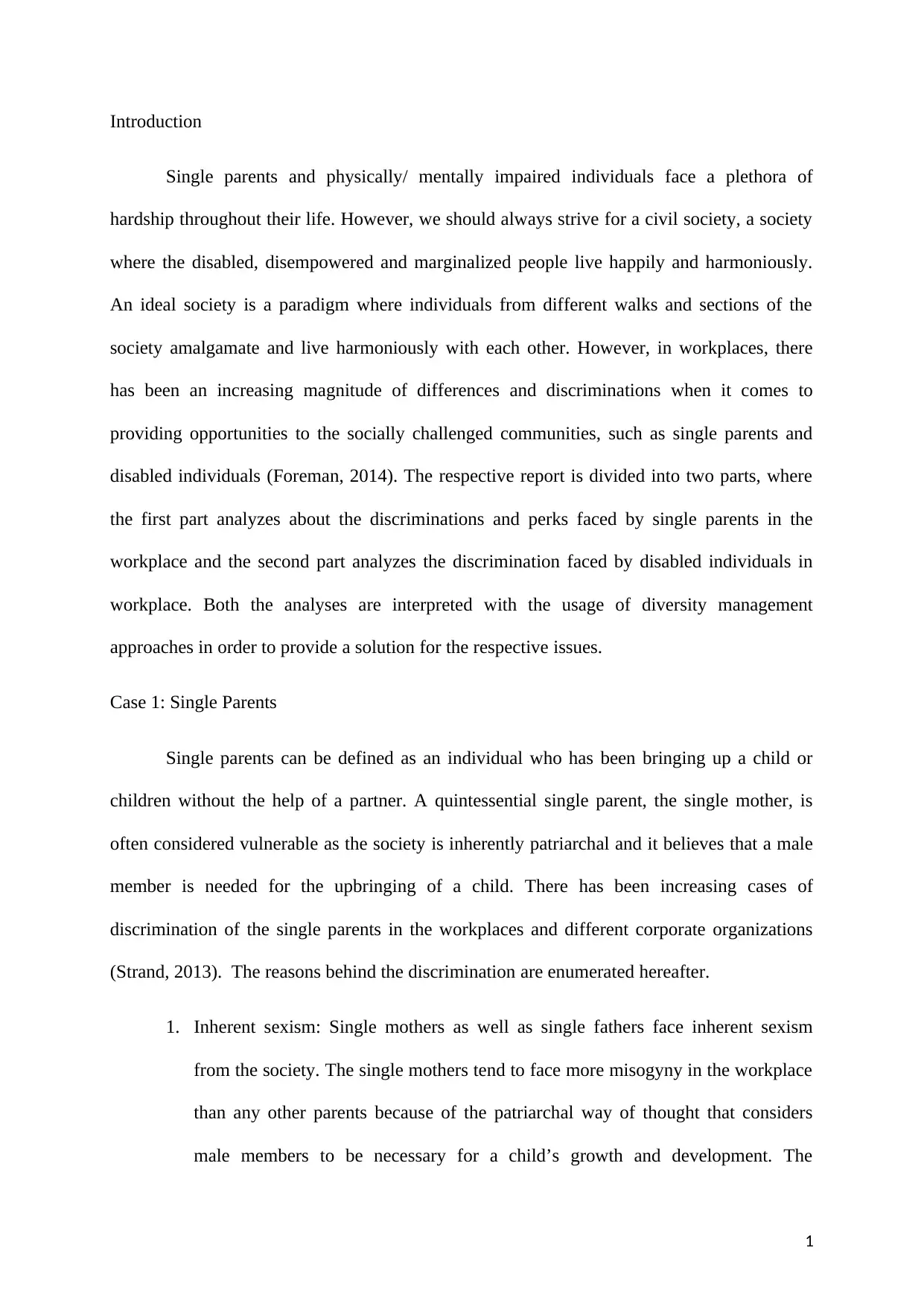
Introduction
Single parents and physically/ mentally impaired individuals face a plethora of
hardship throughout their life. However, we should always strive for a civil society, a society
where the disabled, disempowered and marginalized people live happily and harmoniously.
An ideal society is a paradigm where individuals from different walks and sections of the
society amalgamate and live harmoniously with each other. However, in workplaces, there
has been an increasing magnitude of differences and discriminations when it comes to
providing opportunities to the socially challenged communities, such as single parents and
disabled individuals (Foreman, 2014). The respective report is divided into two parts, where
the first part analyzes about the discriminations and perks faced by single parents in the
workplace and the second part analyzes the discrimination faced by disabled individuals in
workplace. Both the analyses are interpreted with the usage of diversity management
approaches in order to provide a solution for the respective issues.
Case 1: Single Parents
Single parents can be defined as an individual who has been bringing up a child or
children without the help of a partner. A quintessential single parent, the single mother, is
often considered vulnerable as the society is inherently patriarchal and it believes that a male
member is needed for the upbringing of a child. There has been increasing cases of
discrimination of the single parents in the workplaces and different corporate organizations
(Strand, 2013). The reasons behind the discrimination are enumerated hereafter.
1. Inherent sexism: Single mothers as well as single fathers face inherent sexism
from the society. The single mothers tend to face more misogyny in the workplace
than any other parents because of the patriarchal way of thought that considers
male members to be necessary for a child’s growth and development. The
1
Single parents and physically/ mentally impaired individuals face a plethora of
hardship throughout their life. However, we should always strive for a civil society, a society
where the disabled, disempowered and marginalized people live happily and harmoniously.
An ideal society is a paradigm where individuals from different walks and sections of the
society amalgamate and live harmoniously with each other. However, in workplaces, there
has been an increasing magnitude of differences and discriminations when it comes to
providing opportunities to the socially challenged communities, such as single parents and
disabled individuals (Foreman, 2014). The respective report is divided into two parts, where
the first part analyzes about the discriminations and perks faced by single parents in the
workplace and the second part analyzes the discrimination faced by disabled individuals in
workplace. Both the analyses are interpreted with the usage of diversity management
approaches in order to provide a solution for the respective issues.
Case 1: Single Parents
Single parents can be defined as an individual who has been bringing up a child or
children without the help of a partner. A quintessential single parent, the single mother, is
often considered vulnerable as the society is inherently patriarchal and it believes that a male
member is needed for the upbringing of a child. There has been increasing cases of
discrimination of the single parents in the workplaces and different corporate organizations
(Strand, 2013). The reasons behind the discrimination are enumerated hereafter.
1. Inherent sexism: Single mothers as well as single fathers face inherent sexism
from the society. The single mothers tend to face more misogyny in the workplace
than any other parents because of the patriarchal way of thought that considers
male members to be necessary for a child’s growth and development. The
1
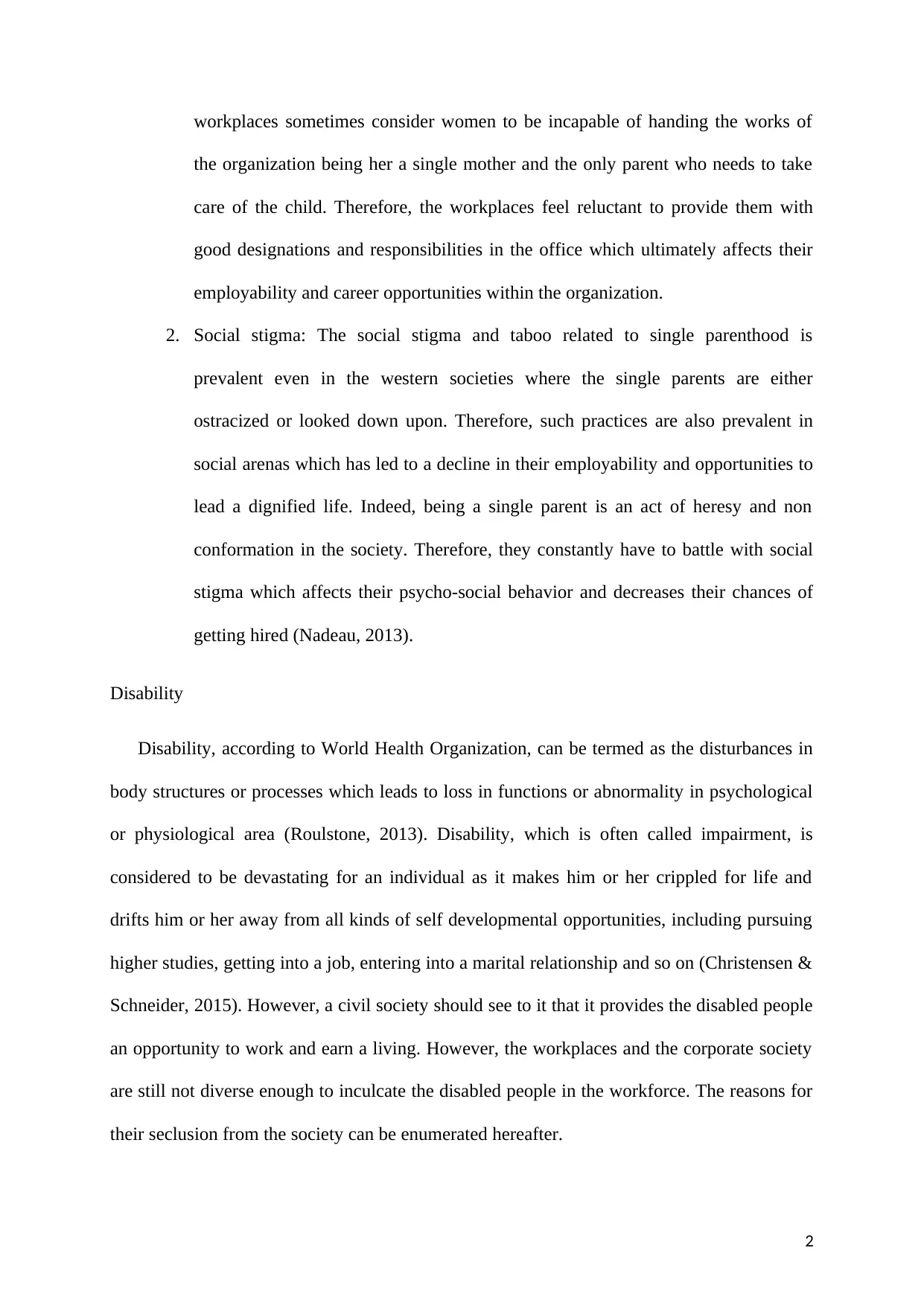
workplaces sometimes consider women to be incapable of handing the works of
the organization being her a single mother and the only parent who needs to take
care of the child. Therefore, the workplaces feel reluctant to provide them with
good designations and responsibilities in the office which ultimately affects their
employability and career opportunities within the organization.
2. Social stigma: The social stigma and taboo related to single parenthood is
prevalent even in the western societies where the single parents are either
ostracized or looked down upon. Therefore, such practices are also prevalent in
social arenas which has led to a decline in their employability and opportunities to
lead a dignified life. Indeed, being a single parent is an act of heresy and non
conformation in the society. Therefore, they constantly have to battle with social
stigma which affects their psycho-social behavior and decreases their chances of
getting hired (Nadeau, 2013).
Disability
Disability, according to World Health Organization, can be termed as the disturbances in
body structures or processes which leads to loss in functions or abnormality in psychological
or physiological area (Roulstone, 2013). Disability, which is often called impairment, is
considered to be devastating for an individual as it makes him or her crippled for life and
drifts him or her away from all kinds of self developmental opportunities, including pursuing
higher studies, getting into a job, entering into a marital relationship and so on (Christensen &
Schneider, 2015). However, a civil society should see to it that it provides the disabled people
an opportunity to work and earn a living. However, the workplaces and the corporate society
are still not diverse enough to inculcate the disabled people in the workforce. The reasons for
their seclusion from the society can be enumerated hereafter.
2
the organization being her a single mother and the only parent who needs to take
care of the child. Therefore, the workplaces feel reluctant to provide them with
good designations and responsibilities in the office which ultimately affects their
employability and career opportunities within the organization.
2. Social stigma: The social stigma and taboo related to single parenthood is
prevalent even in the western societies where the single parents are either
ostracized or looked down upon. Therefore, such practices are also prevalent in
social arenas which has led to a decline in their employability and opportunities to
lead a dignified life. Indeed, being a single parent is an act of heresy and non
conformation in the society. Therefore, they constantly have to battle with social
stigma which affects their psycho-social behavior and decreases their chances of
getting hired (Nadeau, 2013).
Disability
Disability, according to World Health Organization, can be termed as the disturbances in
body structures or processes which leads to loss in functions or abnormality in psychological
or physiological area (Roulstone, 2013). Disability, which is often called impairment, is
considered to be devastating for an individual as it makes him or her crippled for life and
drifts him or her away from all kinds of self developmental opportunities, including pursuing
higher studies, getting into a job, entering into a marital relationship and so on (Christensen &
Schneider, 2015). However, a civil society should see to it that it provides the disabled people
an opportunity to work and earn a living. However, the workplaces and the corporate society
are still not diverse enough to inculcate the disabled people in the workforce. The reasons for
their seclusion from the society can be enumerated hereafter.
2
⊘ This is a preview!⊘
Do you want full access?
Subscribe today to unlock all pages.

Trusted by 1+ million students worldwide
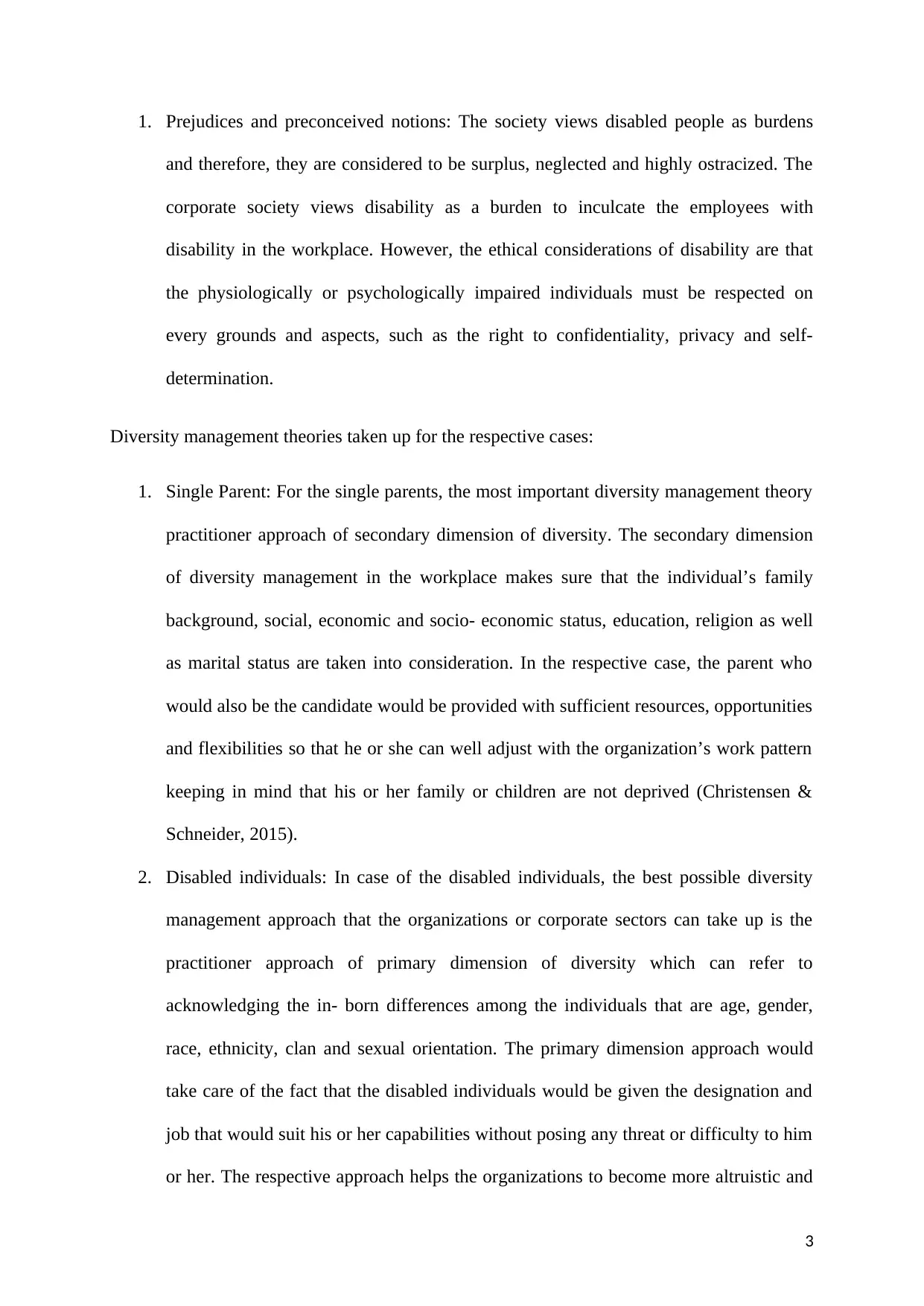
1. Prejudices and preconceived notions: The society views disabled people as burdens
and therefore, they are considered to be surplus, neglected and highly ostracized. The
corporate society views disability as a burden to inculcate the employees with
disability in the workplace. However, the ethical considerations of disability are that
the physiologically or psychologically impaired individuals must be respected on
every grounds and aspects, such as the right to confidentiality, privacy and self-
determination.
Diversity management theories taken up for the respective cases:
1. Single Parent: For the single parents, the most important diversity management theory
practitioner approach of secondary dimension of diversity. The secondary dimension
of diversity management in the workplace makes sure that the individual’s family
background, social, economic and socio- economic status, education, religion as well
as marital status are taken into consideration. In the respective case, the parent who
would also be the candidate would be provided with sufficient resources, opportunities
and flexibilities so that he or she can well adjust with the organization’s work pattern
keeping in mind that his or her family or children are not deprived (Christensen &
Schneider, 2015).
2. Disabled individuals: In case of the disabled individuals, the best possible diversity
management approach that the organizations or corporate sectors can take up is the
practitioner approach of primary dimension of diversity which can refer to
acknowledging the in- born differences among the individuals that are age, gender,
race, ethnicity, clan and sexual orientation. The primary dimension approach would
take care of the fact that the disabled individuals would be given the designation and
job that would suit his or her capabilities without posing any threat or difficulty to him
or her. The respective approach helps the organizations to become more altruistic and
3
and therefore, they are considered to be surplus, neglected and highly ostracized. The
corporate society views disability as a burden to inculcate the employees with
disability in the workplace. However, the ethical considerations of disability are that
the physiologically or psychologically impaired individuals must be respected on
every grounds and aspects, such as the right to confidentiality, privacy and self-
determination.
Diversity management theories taken up for the respective cases:
1. Single Parent: For the single parents, the most important diversity management theory
practitioner approach of secondary dimension of diversity. The secondary dimension
of diversity management in the workplace makes sure that the individual’s family
background, social, economic and socio- economic status, education, religion as well
as marital status are taken into consideration. In the respective case, the parent who
would also be the candidate would be provided with sufficient resources, opportunities
and flexibilities so that he or she can well adjust with the organization’s work pattern
keeping in mind that his or her family or children are not deprived (Christensen &
Schneider, 2015).
2. Disabled individuals: In case of the disabled individuals, the best possible diversity
management approach that the organizations or corporate sectors can take up is the
practitioner approach of primary dimension of diversity which can refer to
acknowledging the in- born differences among the individuals that are age, gender,
race, ethnicity, clan and sexual orientation. The primary dimension approach would
take care of the fact that the disabled individuals would be given the designation and
job that would suit his or her capabilities without posing any threat or difficulty to him
or her. The respective approach helps the organizations to become more altruistic and
3
Paraphrase This Document
Need a fresh take? Get an instant paraphrase of this document with our AI Paraphraser

helpful towards the needy and include them into their collective existence which
would provide them with their due respect and dignity they deserve (Hemphill &
Kulik, 2016). The disabled individuals would also be provided the necessities and all
such requirements which are needed for the growth, development and a holistic
upliftment of the individual. The workplaces would thus be inclusive and highly
diverse with a liberal and an egalitarian environment that would not be helpful for the
organizations but also for the abstract society as a whole (Nota et al., 2014).
Effective cross cultural communication strategies
1. Disabled: For the disabled individuals, communication strategies that the organizations are
suggested to take are:
Serial
Number
Strategy Commentary
1. Inspirational communication
rather than sympathetic
Video and slide shows of
inspirational stories about
success amidst all odds to
motivate them.
2. Altruistic verbal and non-
verbal communication rather
than commanding
Managers should be
provided with proper
training to deal with
differently able
employees. Altruistic
environment within the
workplace.
4
would provide them with their due respect and dignity they deserve (Hemphill &
Kulik, 2016). The disabled individuals would also be provided the necessities and all
such requirements which are needed for the growth, development and a holistic
upliftment of the individual. The workplaces would thus be inclusive and highly
diverse with a liberal and an egalitarian environment that would not be helpful for the
organizations but also for the abstract society as a whole (Nota et al., 2014).
Effective cross cultural communication strategies
1. Disabled: For the disabled individuals, communication strategies that the organizations are
suggested to take are:
Serial
Number
Strategy Commentary
1. Inspirational communication
rather than sympathetic
Video and slide shows of
inspirational stories about
success amidst all odds to
motivate them.
2. Altruistic verbal and non-
verbal communication rather
than commanding
Managers should be
provided with proper
training to deal with
differently able
employees. Altruistic
environment within the
workplace.
4
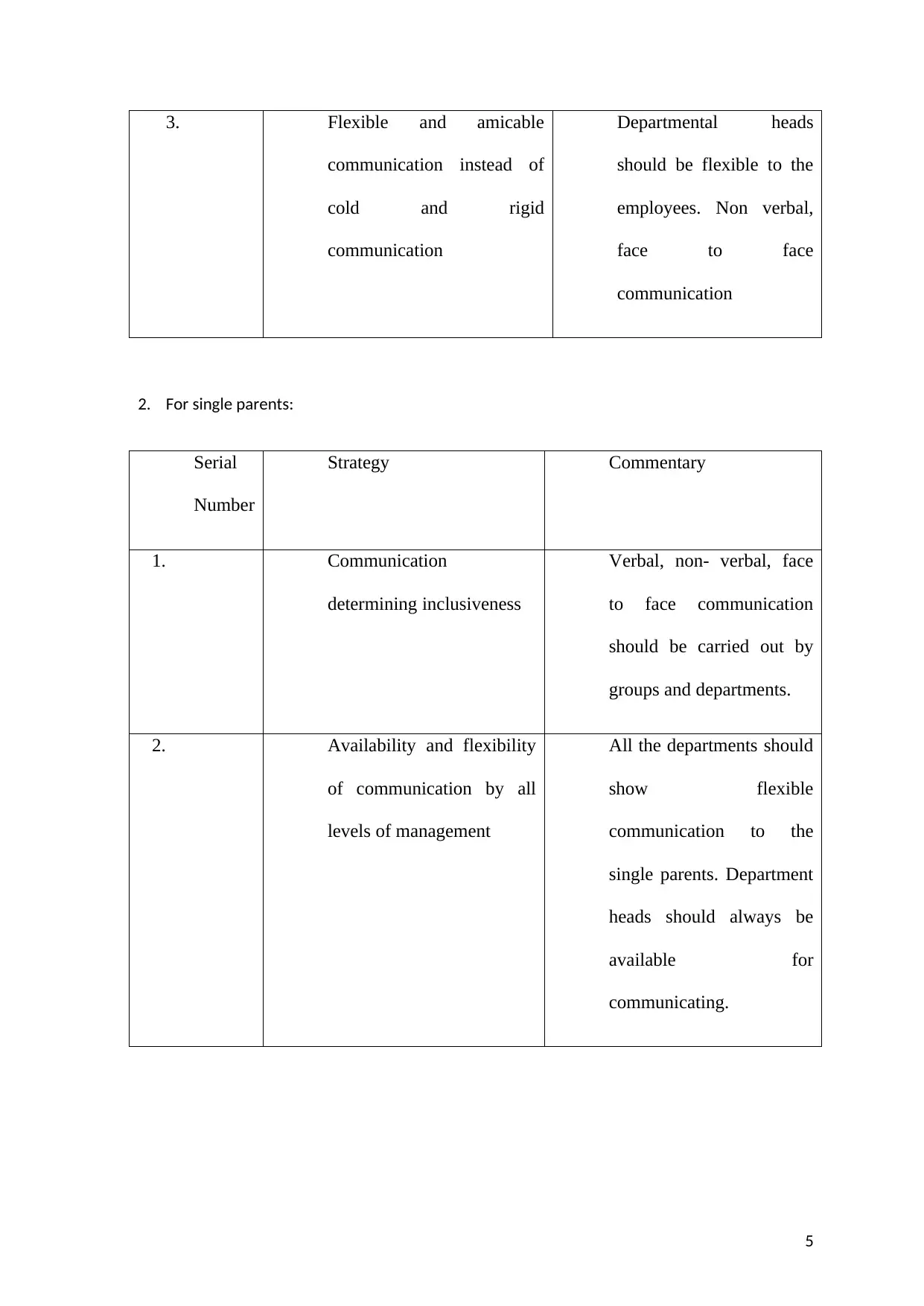
3. Flexible and amicable
communication instead of
cold and rigid
communication
Departmental heads
should be flexible to the
employees. Non verbal,
face to face
communication
2. For single parents:
Serial
Number
Strategy Commentary
1. Communication
determining inclusiveness
Verbal, non- verbal, face
to face communication
should be carried out by
groups and departments.
2. Availability and flexibility
of communication by all
levels of management
All the departments should
show flexible
communication to the
single parents. Department
heads should always be
available for
communicating.
5
communication instead of
cold and rigid
communication
Departmental heads
should be flexible to the
employees. Non verbal,
face to face
communication
2. For single parents:
Serial
Number
Strategy Commentary
1. Communication
determining inclusiveness
Verbal, non- verbal, face
to face communication
should be carried out by
groups and departments.
2. Availability and flexibility
of communication by all
levels of management
All the departments should
show flexible
communication to the
single parents. Department
heads should always be
available for
communicating.
5
⊘ This is a preview!⊘
Do you want full access?
Subscribe today to unlock all pages.

Trusted by 1+ million students worldwide
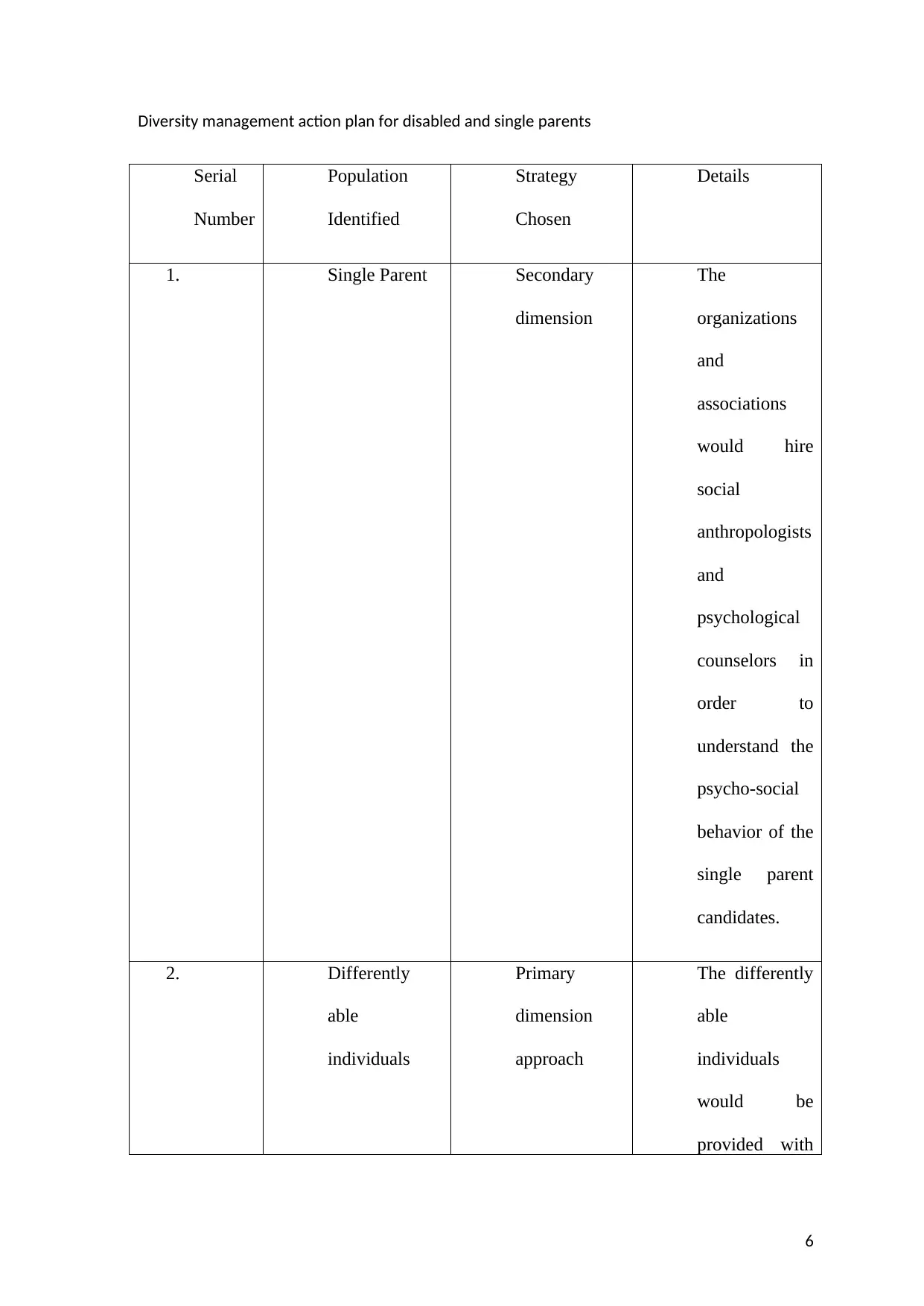
Diversity management action plan for disabled and single parents
Serial
Number
Population
Identified
Strategy
Chosen
Details
1. Single Parent Secondary
dimension
The
organizations
and
associations
would hire
social
anthropologists
and
psychological
counselors in
order to
understand the
psycho-social
behavior of the
single parent
candidates.
2. Differently
able
individuals
Primary
dimension
approach
The differently
able
individuals
would be
provided with
6
Serial
Number
Population
Identified
Strategy
Chosen
Details
1. Single Parent Secondary
dimension
The
organizations
and
associations
would hire
social
anthropologists
and
psychological
counselors in
order to
understand the
psycho-social
behavior of the
single parent
candidates.
2. Differently
able
individuals
Primary
dimension
approach
The differently
able
individuals
would be
provided with
6
Paraphrase This Document
Need a fresh take? Get an instant paraphrase of this document with our AI Paraphraser
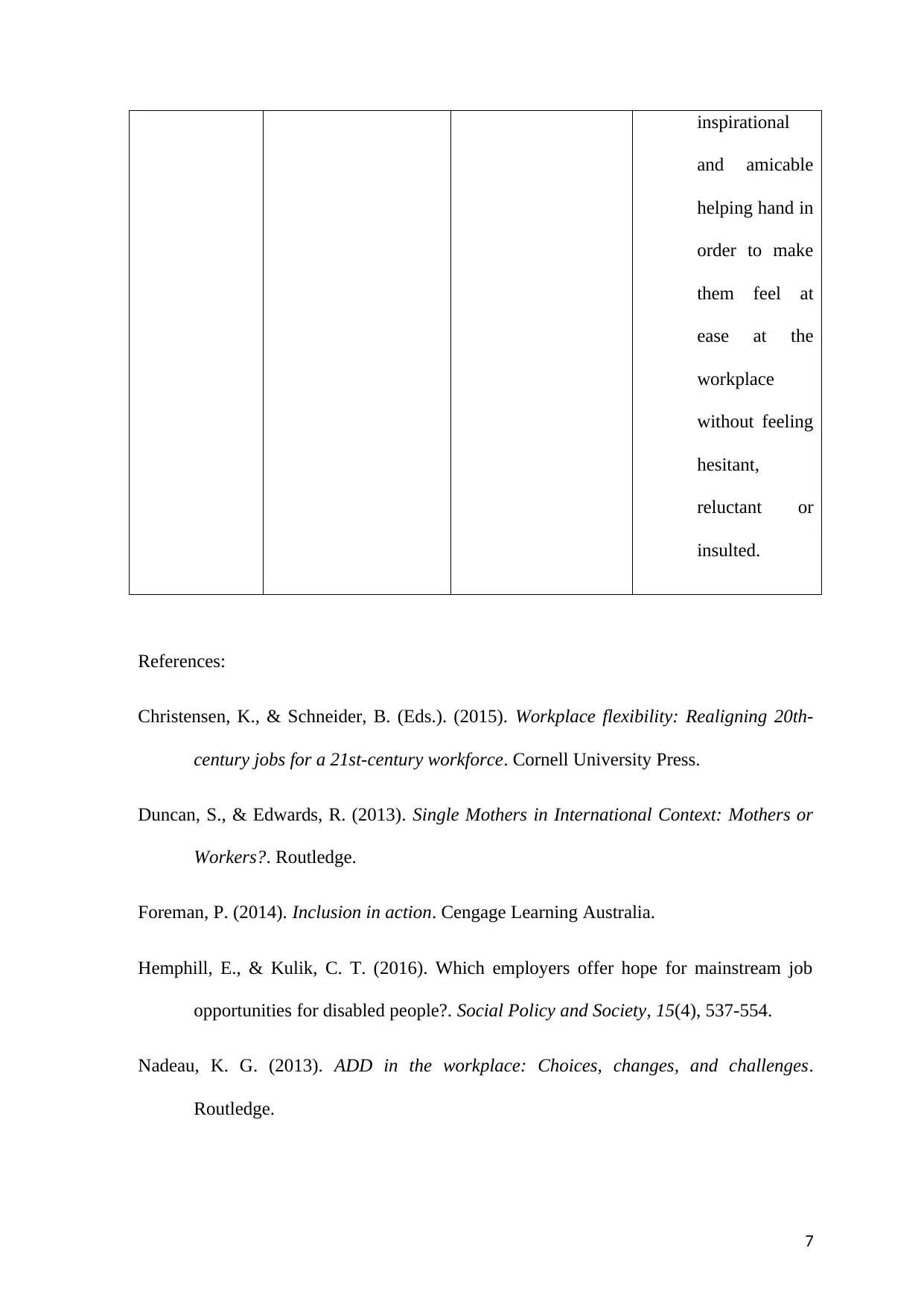
inspirational
and amicable
helping hand in
order to make
them feel at
ease at the
workplace
without feeling
hesitant,
reluctant or
insulted.
References:
Christensen, K., & Schneider, B. (Eds.). (2015). Workplace flexibility: Realigning 20th-
century jobs for a 21st-century workforce. Cornell University Press.
Duncan, S., & Edwards, R. (2013). Single Mothers in International Context: Mothers or
Workers?. Routledge.
Foreman, P. (2014). Inclusion in action. Cengage Learning Australia.
Hemphill, E., & Kulik, C. T. (2016). Which employers offer hope for mainstream job
opportunities for disabled people?. Social Policy and Society, 15(4), 537-554.
Nadeau, K. G. (2013). ADD in the workplace: Choices, changes, and challenges.
Routledge.
7
and amicable
helping hand in
order to make
them feel at
ease at the
workplace
without feeling
hesitant,
reluctant or
insulted.
References:
Christensen, K., & Schneider, B. (Eds.). (2015). Workplace flexibility: Realigning 20th-
century jobs for a 21st-century workforce. Cornell University Press.
Duncan, S., & Edwards, R. (2013). Single Mothers in International Context: Mothers or
Workers?. Routledge.
Foreman, P. (2014). Inclusion in action. Cengage Learning Australia.
Hemphill, E., & Kulik, C. T. (2016). Which employers offer hope for mainstream job
opportunities for disabled people?. Social Policy and Society, 15(4), 537-554.
Nadeau, K. G. (2013). ADD in the workplace: Choices, changes, and challenges.
Routledge.
7
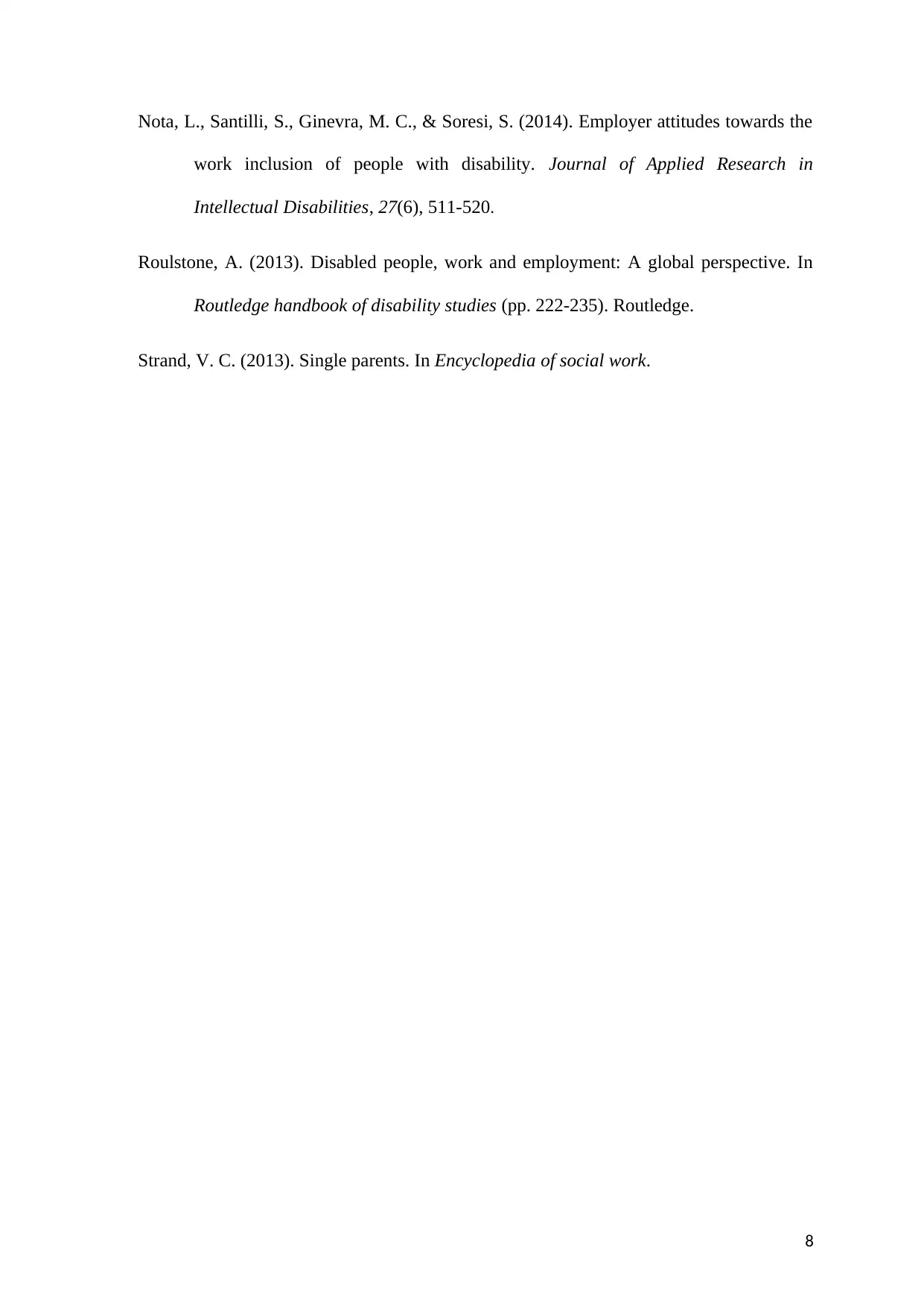
Nota, L., Santilli, S., Ginevra, M. C., & Soresi, S. (2014). Employer attitudes towards the
work inclusion of people with disability. Journal of Applied Research in
Intellectual Disabilities, 27(6), 511-520.
Roulstone, A. (2013). Disabled people, work and employment: A global perspective. In
Routledge handbook of disability studies (pp. 222-235). Routledge.
Strand, V. C. (2013). Single parents. In Encyclopedia of social work.
8
work inclusion of people with disability. Journal of Applied Research in
Intellectual Disabilities, 27(6), 511-520.
Roulstone, A. (2013). Disabled people, work and employment: A global perspective. In
Routledge handbook of disability studies (pp. 222-235). Routledge.
Strand, V. C. (2013). Single parents. In Encyclopedia of social work.
8
⊘ This is a preview!⊘
Do you want full access?
Subscribe today to unlock all pages.

Trusted by 1+ million students worldwide
1 out of 9
Related Documents
Your All-in-One AI-Powered Toolkit for Academic Success.
+13062052269
info@desklib.com
Available 24*7 on WhatsApp / Email
![[object Object]](/_next/static/media/star-bottom.7253800d.svg)
Unlock your academic potential
Copyright © 2020–2025 A2Z Services. All Rights Reserved. Developed and managed by ZUCOL.





